
17 minute read
CCG at UNTITLED, ART Miami Beach 2019
STEPHANIE SYJUCO

UNTITLED, ART Miami Beach Booth A17: Stephanie Syjuco
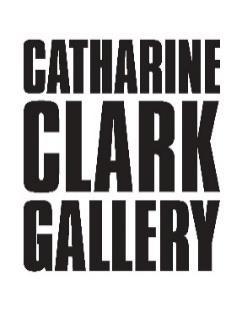
STEPHANIE SYJUCO (American, born in Manila, Philippines, 1974) creates large-scale spectacles of collected cultural objects, photographs, and installations that investigate the political effects of economies and empire.
Syjuco lives and works in Oakland, California and is an Associate Professor of Sculpture at the University of California at Berkeley. She received an MFA from Stanford University and a BFA from the San Francisco Art Institute.

Currently, Syjuco’s work is the subject of a monographic exhibition titled Rogue States at the Contemporary Art Museum St. Louis. In 2018, her work was part of Being: New Photography2018at the Museum of Modern Art, New York, New York; Public Knowledgeat the San Francisco Museum of Modern Art, California; and This Site is Under Revolutionat the Moscow Museum of Modern Art. Syjuco has also participated in Entre, Dentro, Fuera/Between, Inside Outsideat the Twelfth Havana Biennale, Cuba (2015); the Asian Art Biennial 2015at the National Taiwan Museum of Fine Arts, Taichung, Taiwan; Shadow$hop: Local Art for Mass Distribution at the San Francisco Museum of Modern Art, California (2010); 1969 at P.S.1/MOMA, New York, New York (2009); and Political Natureat the Whitney Museum of American Art, New York, New York (2005). Syjuco’s work is represented in the collections of 21c Museum Hotels, Louisville, Kentucky; Berkeley Art Museum and Pacific Film Archive, California; Fine Arts Museums of San Francisco, California; McEvoy Foundation for the Arts, San Francisco, California; Milwaukee Art Museum, Wisconsin; Museum of Modern Art, New York, New York; Pennsylvania Academy of the Fine Arts, Philadelphia; Saint Louis Museum of Art, Missouri; San Francisco Museum of Modern Art, California; University of Kentucky Art Museum, Lexington; and the Whitney Museum of American Art, New York, New York, among many others.
In 2019 Syjuco was the recipient of a Smithsonian Artist Research Fellowship. Other awards have included a Guggenheim Fellowship (2014), and a Joan Mitchell Painters and Sculptors Award (2009). In 2008, she was featured in Season 9 of the acclaimed PBS documentary series Art21: Art in the Twenty-First Century.

Since 2013, she has exhibited with Ryan Lee Gallery in New York and since 2008, she has been represented by Catharine Clark Gallery, where she will have her next solo exhibition in the fall of 2020.
Syjuco’s presentation at UNTITLED, ART Miami Beach features key works from recent projects that explore how photography and other image-based technologies reify structures of power. These recent projects often question ideas around citizenship and what it means to be an American— contested definitions rooted in exclusionary policies and legislation, despite the American ideal of equality for all. Her sculptures and photographs reference genres like still life and ethnographic portraiture as a means to critique questions of empire and nativism that pervade through art history. Syjuco also appropriates tools from photo-based practices—such as color and greyscale calibration charts—in order to explore how these systems of power rely on various forms of intervention, manipulation, and selective editing.
Above: Stephanie Syjuco, Applicant Photos (Migrants) #2,2017. Pigmented inkjet print, 3.6 x 4.2 inches unframed; 20 x 16 inches framed. Edition of 10 + 2AP. Full suite of three photographs, editions 7-9: $16,500


Stephanie Syjuco, (detail) TheVisibleInvisible:PlymouthPilgrim(Simplicity),2018. Hand-sewn chroma key backdrop fabric (cotton muslin), silk, polyester, ribbon, hand crocheted lace, commercial lace, and dress forms, 69 x 48 x 48 inches.
Central to the presentation of Stephanie Syjuco’s work at UNTITLED, ART Miami Beach are three, vibrantly-colored figures from the series The Visible Invisible(2018). The figures are wearing garments that represent iconic moments in American history fabricated out of green chroma key backdrop material. Chroma key is a visual effects technique commonly used in digital post-production, allowing a video or image editor to superimpose new backgrounds behind a subject. By calling attention to the removable backdrop and using it as a material to recreate historical costumes, The Visible Invisible questions how American history itself has been fabricated, manipulated, and constructed—in essence, functioning as a projection screen for convenient (and inaccurate) narratives.
The mythology of the country's founding by the Plymouth Pilgrim (at the expense of native peoples and their sovereignty), the democratic ideals of the American Revolution of 1776 (which only granted citizenship to free white men) and the romanticism of the Antebellum South (the seat of Confederacy and an economy based on slavery and white supremacy), is explored via hand-made construction. Far from being historically accurate, the garments have been produced using commercial sewing patterns for theatrical plays, re-enactments, and Halloween festivities, further highlighting the distance between an authentic past and convenient American narrative.
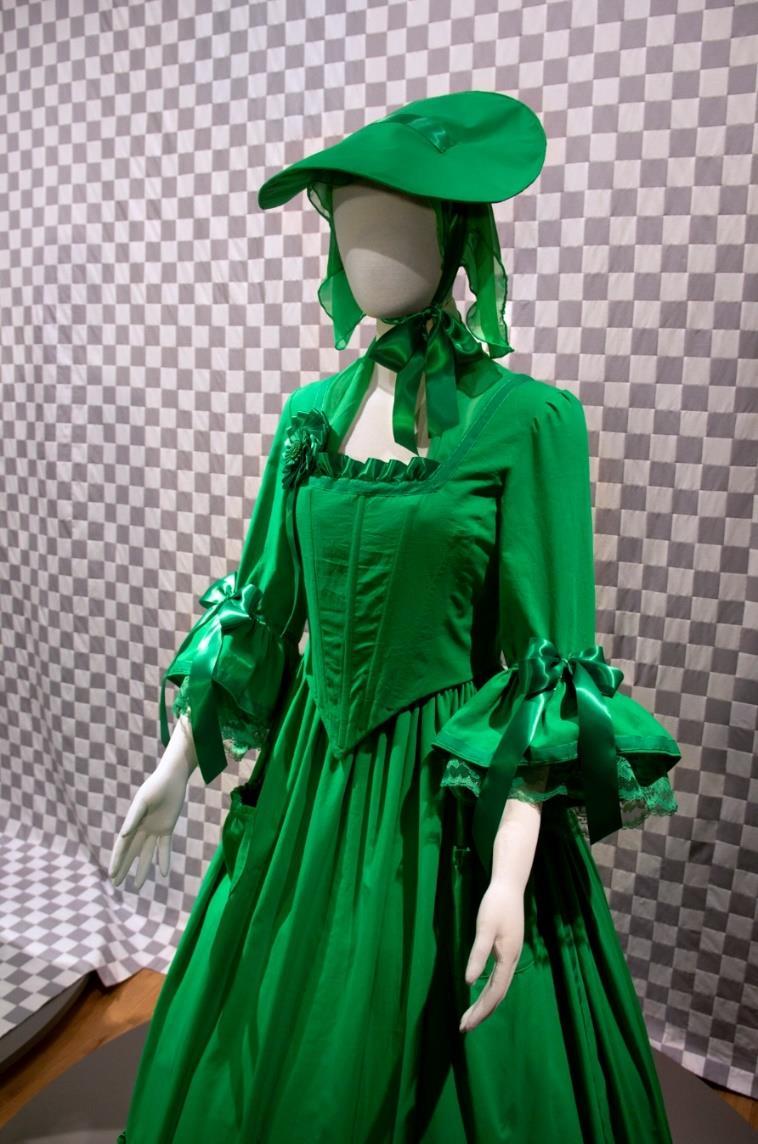
Stephanie Syjuco, (detail)TheVisible Invisible:ColonialRevolution (McCall's),2018. Hand-sewn chroma key backdrop fabric (cotton muslin), silk, polyester, ribbon, hand crocheted lace, commercial lace, and dress forms, 69 x 48 x 48 inches.

Stephanie Syjuco, (detail) TheVisible Invisible:AntebellumSouth (Simplicity),2018. Hand-sewn chroma key backdrop fabric (cotton muslin), silk, polyester, ribbon, hand crocheted lace, commercial lace, and dress forms, 69 x 60 x 60 inches.

Stephanie Syjuco, Chromakey Aftermath (Standard Bearers),2019. Pigmented inkjet print, 40 x 30 inches unframed; 41 x 31 inches framed. Edition of 8 + 2AP. $11,000
Draped behind the costumed figures is a large backdrop featuring an image from Syjuco’s Chromakey Aftermath(2019) series—photographs that reconstruct the physical aftermath of protests against the alt-right and witnessed by the artist in 2017. The photographs feature images of chroma key green fabric and objects. These images bridge the historical reenactments of The Visible Invisiblewith contemporary struggles of unreconciled American identity.
Chromakey Aftermath (Standard Bearers)is a photograph that features two figures consumed by detritus, protest accessories, and flags in chroma key green. Even though the two sitters are surrounded by chroma key fabric, their presence insists on itself. Working with students from University of California, Berkeley where she is a professor, Syjuco created images that speculate on how young people from marginalized communities are defining themselves as resistant activists, despite xenophobic political policies.
PHANTOM FLAG

Stephanie Syjuco, Phantom Flag, 2018, Polyester chiffon, 81 x 141 inches. Edition of 3 + 1AP. $20,000
Phantom Flag(2018) continues Syjuco’s inquiry into how flags and national symbols become metaphors for political contest. Made of sheer black chiffon, the oversized flag is fragile and ghost-like, a symbolic manifestation of a nation haunted by and unresolved in its own conflicts.
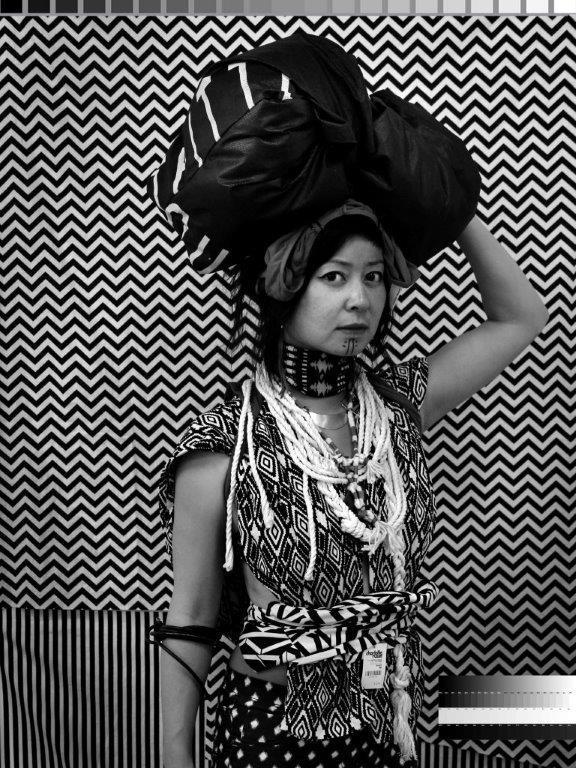
Stephanie Syjuco, Cargo Cults: Head Bundle (Small),2016. Pigmented inkjet print, 20 x 15 inches unframed; 21 x 16 inches framed. Edition of 15 + 2AP. $8,200
The series Cargo Cults(2016) revisits historical ethnographic studio portraiture via fictional display: using mass-manufactured goods purchased from American shopping malls and restyled to highlight popular fantasies associated with “ethnic” patterning and costume. Purchased on credit cards and returned for full refund after the photo shoots, the cheap garments hail from Forever21, H&M, American Apparel, Urban Outfitters, Target, The Gap, and other large corporate stores. Using tactics of dazzle camouflage—a WWI technique in which battleships were painted with graphic black and white patterns to confuse enemy aim—the disruptive geometries shift the viewer’s attention from foreground to background in an attempt to “find” the false subject. Black and white photographic calibration charts are embedded within the pictures, and in some cases overlap and cover portions of the figure, as if to insist that race is something that can be measured.
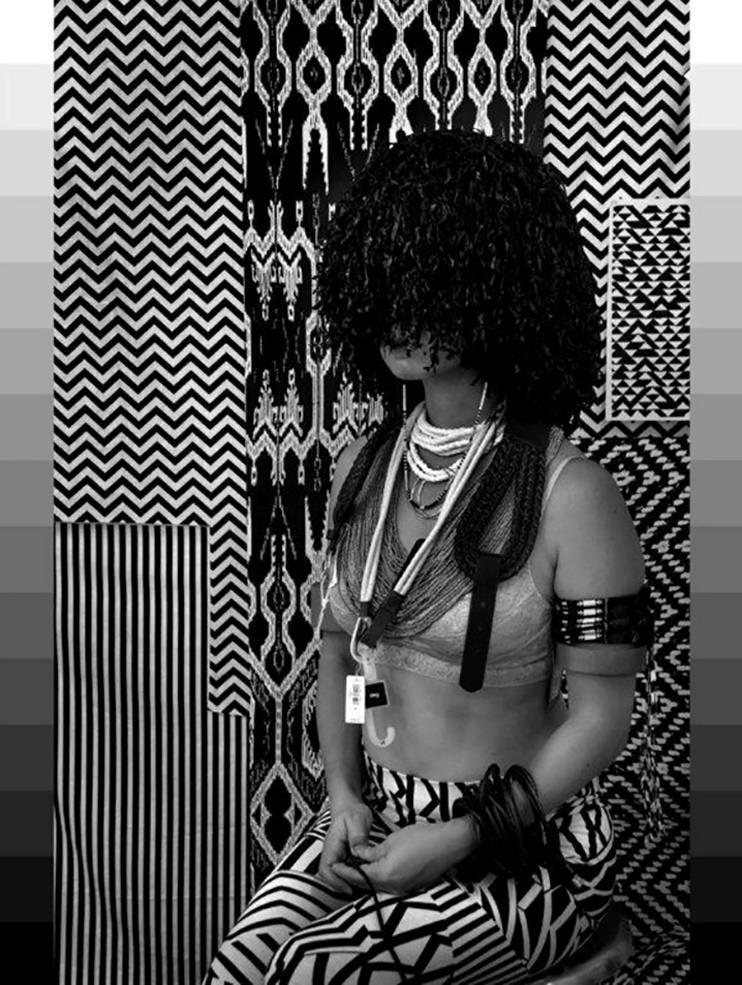
Stephanie Syjuco, Cargo Cults: Basket Woman (Small),2016. Pigmented inkjet print, 20 x 15 inches unframed; 21 x 16 inches framed. Edition of 15 + 2AP. $8,200

Stephanie Syjuco, Cargo Cults: Basket Woman (Small),2016. Pigmented inkjet print, 20 x 15 inches unframed; 21 x 16 inches framed. Edition of 15 + 2AP. $8,200

Stephanie Syjuco, Orange Alert (Fluorescent Orange on White Tulips) in the series "Hard Light", 2019. Pigmented inkjet print, 24 x 30 inches unframed; 25 x 31 inches framed. $12,000
The series Hard Light (2019) refers to a Photoshop filter that overemphasizes lighting conditions on an image and to looking critically at a situation. Syjuco spray paints white Oriental lilies and white tulips as a way to both negate and highlight persistent cultural metaphors about difference. Spraying already white flowers a gloss white means that their whiteness is insistently—even perversely—doubled, while the black and fluorescent orange spray paints alert the viewer to pantomiming gestures of race and representation.

Stephanie Syjuco, Whiteout (Krylon ColorMaster Gloss White on White Oriental Lilies) in the series "Hard Light", 2019. Pigmented inkjet print, 30 x 24 inches unframed; 31 x 25 inches framed. $12,000

Stephanie Syjuco, Blackout (Krylon ColorMaster Gloss Black on White Oriental Lilies Sprayed Gloss White) in the series "Hard Light", 2019. Pigmented inkjet print, 30 x 24 inches unframed; 31 x 25 inches framed. $12,000
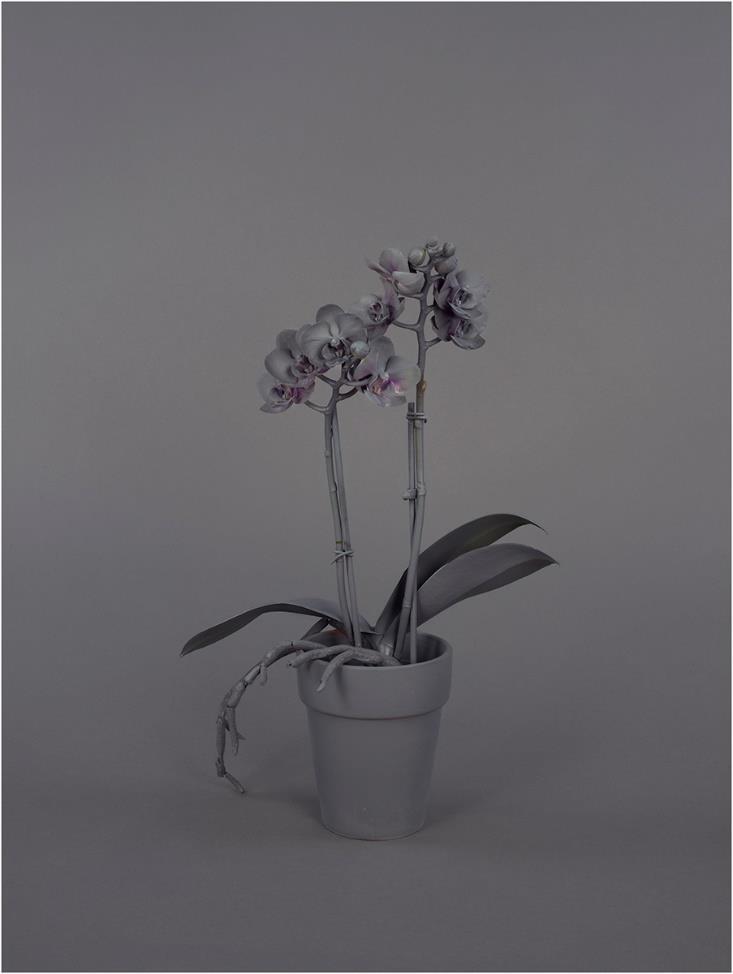
Stephanie Syjuco, Neutral Orchids (Phalaenopsis, small),2016. Pigmented inkjet print, 20 x 15 inches unframed; 20 3/4 x 15 3/4 inches framed. Edition of 10 +2AP. $8,200 framed
NeutralOrchids(2016) are photographs of living orchids that have been sprayed with industrial grey primer paint and then photographed against a neutral grey background. Appearing ashen and unreal, their living form is revealed by the slight reveal of color on areas that have escaped paint. As "exotic" flowers that have since been cloned ad infinitum and marketed to the public, orchids bear the weight of being at once foreign, domestic, and a common decorator item that connotes elegance and distant tropical splendor. By physically neutralizing the orchids with primer paint, the photographs are blank canvases upon which we can further project. Suspended between life and death (they eventually die after several weeks of struggle and even bloom after the initial coverage of paint), they articulate their physical burden of representation, perhaps becoming a newly-made possibility—caught in suspended animation as photographs.
Altogether these works showcase Syjuco’s focus on how culture and politics are constructed via mediated and manipulated images. Nothing is neutral. Our own systems of representation are trapped in both contemporary and historical forms of vision.

Stephanie Syjuco, Neutral Orchids (Dendrobium),2016. Pigmented inkjet print, 24 x 18 inches unframed; 24 3/4 x 18 3/4 inches framed. Edition of 10 +2AP. $5,800
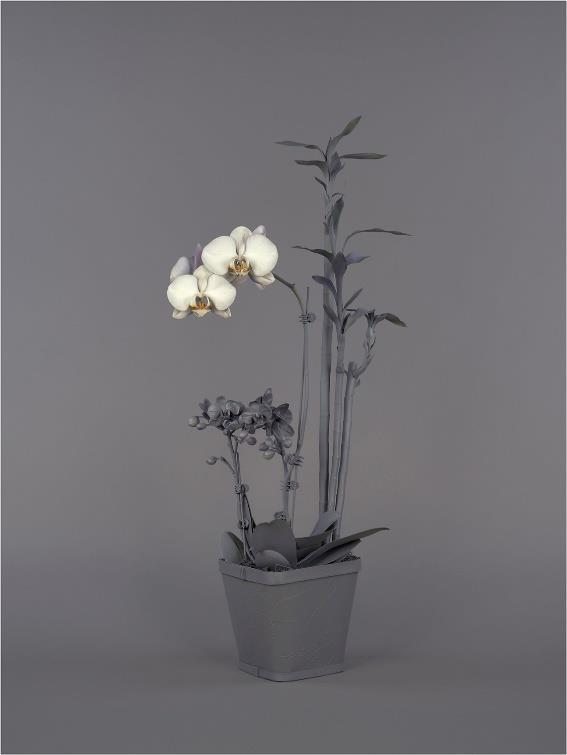
Stephanie Syjuco, Neutral Orchids (Phalaenopsis + Dracaena sanderiana), 2016. Pigmented inkjet print, 32 x 24 inches unframed; 33 1/4 x 25 1/4 framed. Edition of 10 +2AP. $13,000

Stephanie Syjuco, Neutral Orchids (Phalaenopsis + Dracaena sanderiana 2), 2016. Pigmented inkjet print, 32 x 24 inches unframed; 33 1/4 x 25 1/4 framed. Edition of 10 +2AP. $9,500

Deborah Oropallo and Andy Rappaport, still from FLIGHT, 2019.
FLIGHT (2019) is the newest multi-channel video installation by Deborah Oropallo and Andy Rappaport. The title refers to mass migration and global displacement—the geo-political crises of our time. In a worldwide catastrophe of mass flight brought about by climate change, persecution, regional conflict, food shortage, drought, flood, and/or fire, humans are losing their homes. Those displaced are people—call them migrants, refugees, asylum seekers, expats; call their experience migration, resettlement, or displacement—and their flight is a humanitarian tragedy.
In the split-screen video installation, which is suitable for presentation indoors or outside, boats continuously cross a vast and dark ocean. As the vessels reach the shore the faces of occupants draw closer to the viewers. We witness courage, desperation, fear, loss, and hope in their countenances. We see the provisional means of transport and escape reflecting the customs and traditions of their former homelands: wooden boats, inflatables, and hand-built rafts made of anything that floats. Try to imagine a perilous journey in flimsy, overcrowded boats, across unknown and unforgiving waters, carrying only what is in your pockets. Now, try to imagine whether you will be taken-in where you land or sent back out to sea. Some people are given life vests when they start their journeys; others nothing. Some people are greeted at shore by open arms; others are met by walls and rejection. Imagine what for many of us is unimaginable.
The boats arrive from all over the world: Syria, Cuba, Sub-Saharan Africa, Libya, Somalia, Myanmar…. If we only speak about global displacement, the tragedy becomes one of statistics, not people. The numbers seem too large to fathom; too distant from anything any one of us can comprehend. We are not called upon to consider the travelers’ humanity: the midvoyage peril, parents lifting babies above their heads in hope of salvation, children carrying grandparents, people swimming to shore among bodies, the living and the dead floating side by side. These images are the ones that this video asks the viewer to ponder.

Each ornate gold frame housing a monitor and resembling those frequently seen on historic paintings, reminds us of the ubiquity of tragic histories, such as those memorialized and allegorized in paintings like Gericault’s The Raft of the Medusa (1818 –1819), Delacroix’s After the Shipwreck (1847), or Winslow Homer’s The Life Line(1884). FLIGHTconsiders and laments the disastrous consequences of exodus then and now. The frames are also meant to evoke family portraits, such as those of our own ancestors, most of whom faced their own migrations.
The images in FLIGHT are drawn from internet news sites and sourced by country. Various photographs taken on location of scenes occurring in real time are layered and montaged. Collectively, the images tell a story that the 24-hour news cycle cannot capture. Our attention has become so short that most of these disaster photographs–all easily found and in public view–are buried by the ever-growing accumulation of fresh events. The artists invite viewers to consider the cascade of human tragedies that will occur as we face the greatest migration driver in human history: climate change.
Above: Deborah Oropallo and Andy Rappaport, Installation view at the Triton Museum of Art, Santa Clara, California: FLIGHT, 2019. Nine-channel video installation with two channel sound, gold frames, approximately 120 x 144 x 60 inches. 11:00 minutes looped. Edition of 3 + 2AP. $45,000 (not inclusive of equipment or installation costs).

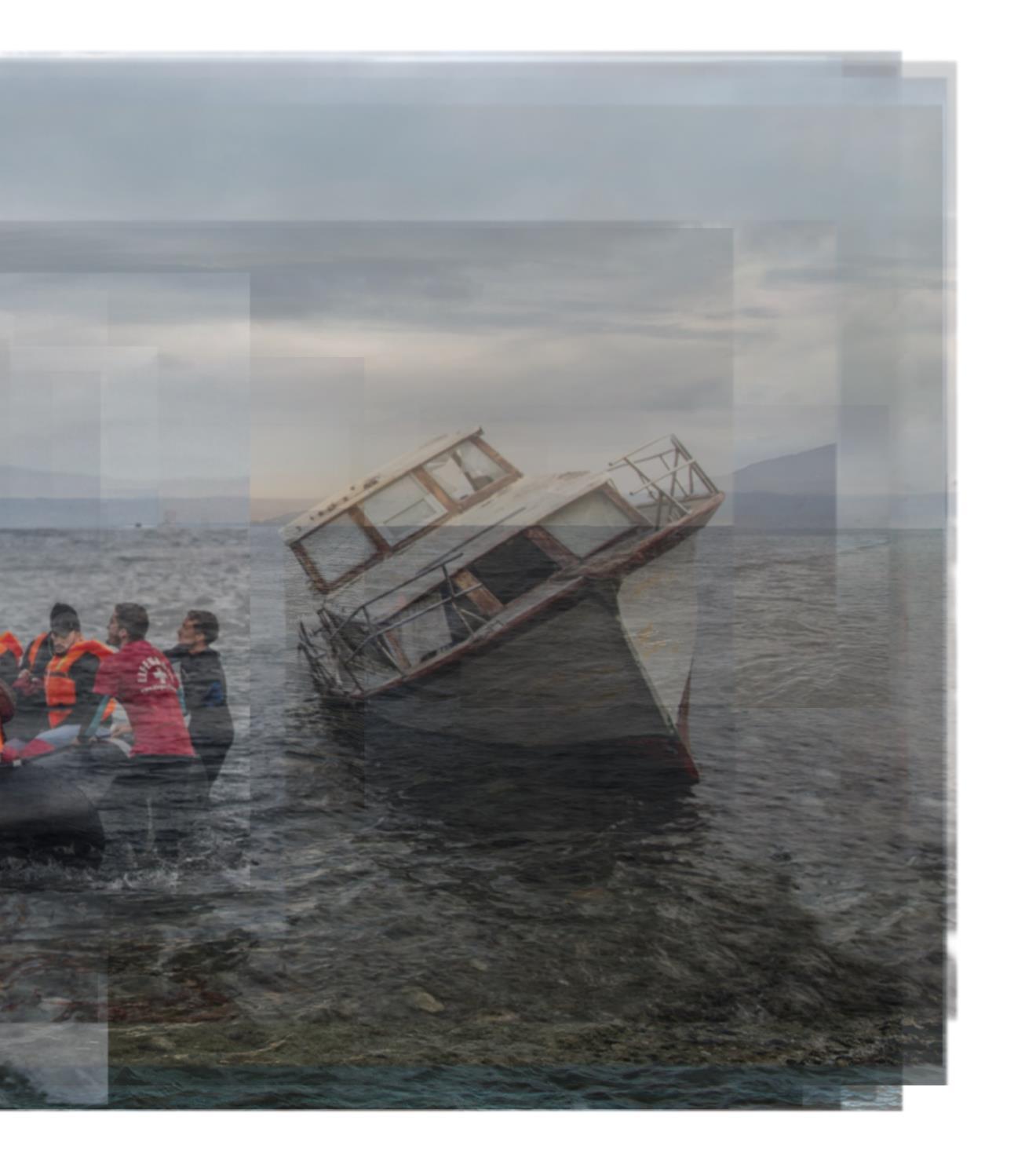
Deborah Oropallo and Andy Rappaport, still image from FLIGHT, 2019.

Above: Deborah Oropallo and Andy Rappaport, still image from FLIGHT, 2019.
Back Cover: Deborah Oropallo and Andy Rappaport, Concept view for UNTITLED, ART Miami Beach: FLIGHT, 2019. Nine-channel video installation with two channel sound, gold frames, approximately 120 x 144 x 60 inches. 11:00 minutes looped. Edition of 3 + 2AP. $45,000 (not inclusive of equipment or installation costs).
DEBORAH OROPALLO (American, born in Hackensack, New Jersey, 1954) received an MA/MFA from the University of California at Berkeley and a BFA from Alfred University. Originally trained as a painter, Oropallo incorporates mixed media techniques, including photomontage, video, computer editing, printmaking, and painting into her practice. Whether still or moving images, the resulting works bear traces of the distortions that evolve or remain from the image manipulation. Her composite works layer visual sources producing dense interplay between time, place, form, and content. She has collaborated on video works with Andy Rappaport since 2017.
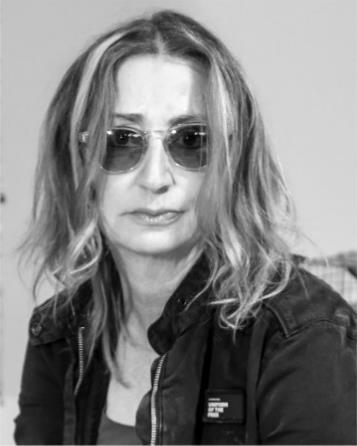
Oropallo’s exhibition history includes monographic exhibits at the Fine Arts Museums of San Francisco, California; the Boise Art Museum, Idaho; Montalvo Art Center, Saratoga, California; the San Jose Museum of Art, California; and work in exhibits at the Whitney Museum of American Art (Whitney Biennial), New York, New York; the San Francisco Museum of Modern Art, California; The Corcoran Gallery of Art (Corcoran Biennial), Washington DC; and The Jewish Museum, New York, New York. Oropallo’s work is in the collections of the San Francisco Museum of Modern Art, California; the Whitney Museum of American Art, New York, New York; the Fine Arts Museums of San Francisco, California; the Museum of Modern Art, New York, New York; and the Anderson Collection at Stanford University, California. The collaborative video work with Andy Rappaport titled Smoke Stacked(2017) is in the Nevada Museum of Art, collected as a part of their ongoing initiative to support works operating at the intersection of art and the environment. The artists’ video FLIGHT(2019) is currently featured in a solo exhibition at The Triton Museum of Art in Santa Clara, California.
Oropallo’s work is the subject of two monographs: POMP(2009) published by Gallery 16, and How To, published by the San Jose Museum of Art. She is a recipient of a National Endowment for the Arts Award, a Eureka Fellowship from the Fleishhacker Foundation, the Engelhard Award, and a grant from the PollockKrasner Foundation.
Oropallo lives in West Marin, California and has been represented by Catharine Clark Gallery since 2013.
ANDY RAPPAPORT (American, born in New York, New York, 1957) has had a nearly 50-year long involvement with music and sound and his experience ranges from fronting rock-and-roll bands, to performing as a singersongwriter, to designing and building recording studios and equipment.

Rappaport’s collaboration with Deborah Oropallo on the video works for Dark Landscapes for a White Housemarked his first foray into music for moving images since scoring student films in the 1970s and draws on his experiences at that time with some of the earliest commercially available music synthesizers.
The artistic partnership between Oropallo and Rappaport is on-going and their collaborative work constitutes more than eight video projects. Their installations have been included in Digital Nature IIat the Los Angeles Arboretum, Pasadena, California; Natural Discourseat the Sagehen Creek Field Station, near Lake Tahoe, California; and FLIGHTat The Triton Museum of Art, Santa Clara, California. FLIGHTwill be exhibited in 2020 at the Schneider Museum of Art at Southern Oregon University, Ashland. In January 2020, the artists will show FLOODat the entrance to UNTITLED, ART San Francisco.
Rappaport is the co-founder, with his wife, Deborah Rappaport, of Minnesota Street Project in San Francisco, CA. He is also a photographer. Rappaport’s collaborative work with Oropallo is represented by Catharine Clark Gallery.
DEBORAH OROPALLO ANDY RAPPAPORT

UNTITLED, ART Miami Beach Ocean Beach: Oropallo and Rappaport December 4-8, 2019 Ocean Beach and 12 th Street Miami Beach, FL 33139 untitledartfairs.com/Miami-beach


